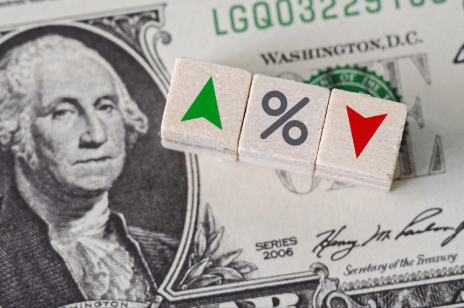
How is Gold Measured? Weighing the Precious Metal
When defining the value of a piece of gold, there are two factors that come into consideration. Firstly, the weight of gold is measured to determine the mass of the metal. In addition, the purity (or fineness) of the gold must be known so you can calculate the true gold content of any given alloy. Even the purest gold coins and bars are not 100% gold, so you need to know both the weight and the purity to decide the value of your precious metal.
The units used to weigh gold are not the same as most other everyday substances, although any unit can technically be used. The majority of the world today uses the metric system, a measurement that uses the meter, liter, and gram to define distance, volume, and mass. Smaller and larger units of the metric system are all derived from these three terms, for example, one kilogram is 1000 grams, and one deciliter is 1/10th of a liter or 100 milliliters.
The metric system was created by the United Kingdom and was adopted by much of the world, given its straightforward units of measurement split into round numbers of 10 and 100. However, the United States did not adopt the metric system and continues to use the United States customary system. This system includes measurements of the mile, cup, pound, and ounce.
Gold and other precious metals have their own special unit of measurement, which is used only for specific materials. This is the troy ounce, which is the most popular unit of measurement for any bullion product. Grams are also used to weigh gold when smaller and more accurate measurements are needed, but the troy ounce remains the most traditional way to weigh out your precious metals.
Regular Ounce vs Troy Ounce
The troy ounce is still the most common unit of measurement for gold, as well as any other precious metal. It’s important not to confuse the troy ounce with the avoirdupois ounce, as the two do not equal the same mass. The Avoirdupois system measures in pounds and ounces and was the most common system of measurement originating in the 13th century. In 1959, the international avoirdupois system was created and spread throughout the British colonies. The United Kingdom, the United States, and Canada all used these units of measurement.
This measurement system was based on a historically standardized pound, which could be split into 16 ounces. The reason that 16 parts were used instead of a rounder number such as 10 or 15 is so that the larger measure could be halved, halved, and halved again. This made unofficial weighing easier as the larger mass could be split more easily into two equal halves. The United States still uses this system today, whereas other nations moved on to a more accurate science-based metric system. But which system do we use for precious metals?
The answer is neither. An alternative unit of measure was adopted for use with precious materials, including metals and gemstones. This was the troy ounce and the entire troy system of measurement. One regular or avoirdupois ounce weighs approximately 28.35 grams, while a troy ounce is more than 2.75 grams heavier at 31.103. While this might seem like a small difference, a few grams in the world of precious materials can equal hundreds of dollars.

The troy ounce is still the most popular measurement for gold.
The Troy System
The only part of the troy weight system remaining in use today is the troy ounce, however, there were many more units of measurement previously. This measurement system used the grain as its smallest unit, then the pennyweight (24 grains), the troy ounce (20 pennyweights), and the troy pound (12 troy ounces). The pennyweight (dwt) is still used in jewelers and equals 1.555 grams. Interestingly, the troy grain is equal in weight to the dram of the avoirdupois system. The troy ounce as we mentioned is heavier than the standard ounce, but the troy pound is actually lighter than the avoirdupois pound.
The Weights and Measures Act of 1878 abolished both the British pennyweight and the troy pound, yet the troy ounce remained an official unit of measure. The troy ounce has been the official weight standard for the United States coinage since 1828. While there are many units of measure used all around the world to weigh gold, gemstones, and other precious materials, the troy ounce remains the standard for bullion and solid gold.
Tola
A tola is a unit of measurement originating in India and other Asian countries. It can also be written as tolah or tole. This Hindi term is derived from the Sanskrit word for weight or weighing; tol. The weight of one tola was quite varied in ancient times as it was determined by the weight of 100 Ratti seeds, so the unit of measure would change slightly each time.
In the present day, the weight of one tola has been standardized to equal 180 troy grains or exactly ⅜ of a troy ounce. This is the equivalent of approximately 11.66 grams. While the tola isn’t used as much as past times, it’s still a common unit to measure gold in India, Pakistan, Bangladesh, Singapore, and Nepal. Gold bars from Asian countries are often produced in denominations of the tola.
Tael
The tael is China’s unit of measurement for gold, which was standardized to 50 grams in 1959. This measurement system is used in mainland China as well as Hong Kong, Taiwan, and Singapore. A 5 tael gold bar is the same as 6.02 troy ounces, worth more than 11,000 American dollars. As well as weighing gold and silver, the Chinese Tael is used in various areas of herbal medicine.
What about Karats?
Karat is another unit of measurement used to weigh precious materials. However, karats are rarely used to describe gold and are intended for diamonds and other gemstones. One karat is equal to 200 milligrams or 0.2 grams. A single karat of gold would be worth $12.13, but the precious metal is rarely available in quantities this small. Diamonds and precious gems need their own unit of measurement as they’re incredibly valuable in small quantities, so tiny 0.2-gram karat denominations are necessary.
Measuring the Purity of Gold
As we mentioned in the introduction, you cannot calculate the value of gold with only a single measurement of weight. To know how much a piece of gold is worth, you need to know both the mass and the purity so that you can figure out the true gold content. Even the purest solid gold is not 100% precious metal, so knowing how to measure the purity of gold is an important part of valuing your precious metals.
The unit used to measure purity in gold is karats, not to be confused with carats. Karats are a unit of weight measurement, used for tiny precious stones. Karats, on the other hand, describe the fineness of a precious metal. Gold is a highly malleable and ductile substance, meaning it’s too soft to use for many purposes. That’s why gold is commonly alloyed with much harder metals to create less pure metal, making it cheaper and easier to use.
Karats are a measurement used only for gold, but any given metal has a certain millesimal fineness. The fineness of gold is expressed in units of parts per 1000, stating what portion of the metal is pure gold. Millesimal fineness is used to denote the purity of platinum, gold, and silver. You may see the fineness of gold written as karats, as a percentage, a hallmark stamp, or a decimal number. Here are the karat conversions you need to know:
- 24-Karat Gold (24k): With a millesimal fineness of 995+, 24 karat gold is considered 100% pure. In actuality, truly pure gold isn’t possible with modern refinement technology, and the finest gold we’re able to achieve is 0.99999 fineness from the Royal Canadian Mint. Any piece of gold with a fineness of at least 995 parts out of 1000 is considered pure 100% gold.
- 22-Karat Gold: Not quite as soft as 24k gold, 22 karats mean a minimum of 834 parts of one thousand is pure gold. 22k gold is 83% precious metal, alloyed with less valuable material.
- 18-Karat Gold (18k): 750 gold is 18 karats, a minimum of 75%, or ¾ gold. Karats are measured out of a total of 24 parts, to 18 karat gold is 18 parts of 24 pure gold.
- 14-Karat Gold (14k): The most common purity level used in jewelry, 14 karat gold is 14 parts gold and 10 parts alloy. The millesimal fineness of 14k gold is 583, it’s 58.5% pure gold.
- 10-Karat Gold (10k): 10 karat gold has less than half of its mass as a precious metal, and in many countries, it wouldn’t be considered “real gold”. The hallmark of 10 karat gold can be written as 417 or .417, meaning 41.7% pure gold.
Gold Bullion Coins and Bars
Central banks, government mints, and bullion dealers usually concentrate on 24 karats 999 fineness gold bars. The London Bullion Market Association defines a standard gold bar as 400 troy ounces, measuring from 21-29 cm in length, 5.5-8.5 cm in width, and 2.5-4.5 in height. This means that a standard-sized gold bar would be worth more than half a million dollars, an amount most investors don’t bandy around freely.
Private bullion dealers and investors generally use much smaller and more affordable gold bar sizes, making a gold investment much more accessible. Common gold bullion bar sizes include 1 kilogram, 10 troy ounces, 100 grams, and 50 grams. Gold bars continue to much smaller sizes, all the way down to a tiny 1 gram bar. However, for weights of one troy ounce and less, bullion coins are a more popular and appropriate choice.
Gold bars are generally very pure, with the highest gold content available from the given producer. Gold coins, on the other hand, tend to have slightly more alloyed metal content to ensure they maintain their intricate designs. One important aspect to remember is that, when buying a bullion coin, the quoted weight is the true pure gold content. One of the best one-ounce gold bullion coins such as the American Eagle will contain one full troy ounce of pure gold, plus a few extra grams of base metal.
How is White Gold Measured?
Because white gold has a different hue to yellow gold, you might think that the precious metal content is lower. In fact, a 10 karat white gold ring has the same gold content as a regular 10 karat gold ring. The white color of white gold comes from the rhodium plating and in no way means that the gold content of your item has been reduced. White gold can be measured in weight, value, and fineness in the same way as regular gold.

Most gold bullion will have a measurement listed on them.
How to Calculate the Value of Gold
If you want to work out how much a piece of gold is worth, there are a few things you need to know. Gold jewelry can be sold off for its gold content at melt value. But before heading out to the pawnshop, you need to know how much your jewelry is worth. It’s unlikely you’ll find a pawnbroker or precious metals dealer who will pay the spot price for gold jewelry, but it’s still a good place to start.
First, you’ll need to look for marks on your jewelry which tell you the purity or fineness of the gold. If you find a karat number denoting the parts of gold out of 24, you can move on to the next step. If you find a different hallmark, you’ll need to convert the value to karats before calculating the value. Another common label found on gold jewelry is in the form of a three-digit number telling you the parts out of 1000 pure gold. If you find a hallmark of the millesimal fineness, divide the value by 1000 and then multiply by 24 to calculate the number of karats.
If your piece of gold is of unknown quality, you can test it to find out the purity. Home gold testing kits are available, or you can take your item to a jeweler for professional advice. Nitric acid is used to figure out the purity of gold by scratching a small amount of metal from your item. This is then mixed with varying concentrations of nitric acid, and the chemical reaction color tells you how pure the gold is. Once you know the number of karats in your gold jewelry, you can calculate how much it is worth.
Divide the number of karats by 24 and then multiply the result by 100; this is the percentage of pure gold in your piece of precious metal. Now, weigh your gold using an accurate scale and take down the measurement to the nearest 10th of a gram. To calculate the melt value of your gold item, multiply its weight in grams by the current spot price of gold, and then by the percentage of purity. For example, a 5 gram 14 karat gold ring has a purity of 58.3%, which is 0.583 as a decimal. Today’s gold price is approximately $60 a gram, so the equation is 5 x 0.583 x 60. The melt value of this ring would be $174.90 USD.
Conclusion:
There are plenty of different measurement options if you want to weigh your gold, but the troy ounce is king when it comes to precious metals. The troy system of measurement went out of style more than 100 years ago, and the pennyweight, troy pound, and troy grain were no longer used. However, since the majority of leading gold traders around the world had standardized to the troy ounce, this unit of measurement remains the standard for gold.
Certain countries prefer the metric system and may sell gold bullion in denominations of 10 or 100 grams. India and parts of Asia use the Tola, which equals exactly ⅜ of a troy ounce. Other areas of Asia including China and Taiwan use the Tael, which is the same as 1.204 troy ounces. Just don’t get karats confused with carats, as 1 carat is only 0.2 grams.
The value of your gold cannot be defined only by weight, as rarely is gold ever sold at 100% purity. Solid gold bars have a millesimal fineness of 995 up to 999.99, which is as close as is possible to entirely pure gold. That’s why you need to know both the weight and purity of a gold item before you can start thinking about its value. If you buy a bullion coin, the weight listed is the mass of pure gold contained within, not the total weight of the item. That means if you buy a 1 troy ounce Golden Eagle, you’ll receive a full ounce of gold plus a few extra grams of alloy metal.
The financial market is crumbling and EVERYONE will be affected. Only those who know what's going on and PREPARE will survive... dare we say thrive. Our 7 Simple Action Items to Protect Your Bank Account will give you the tools you need to make informed decisions to protect yourself and the ones you love.









